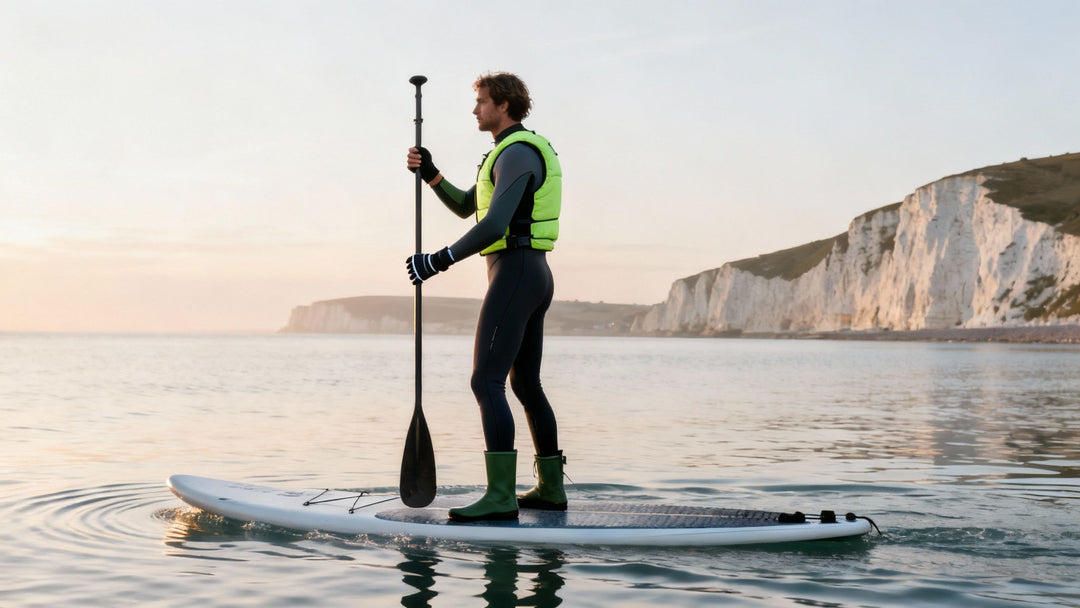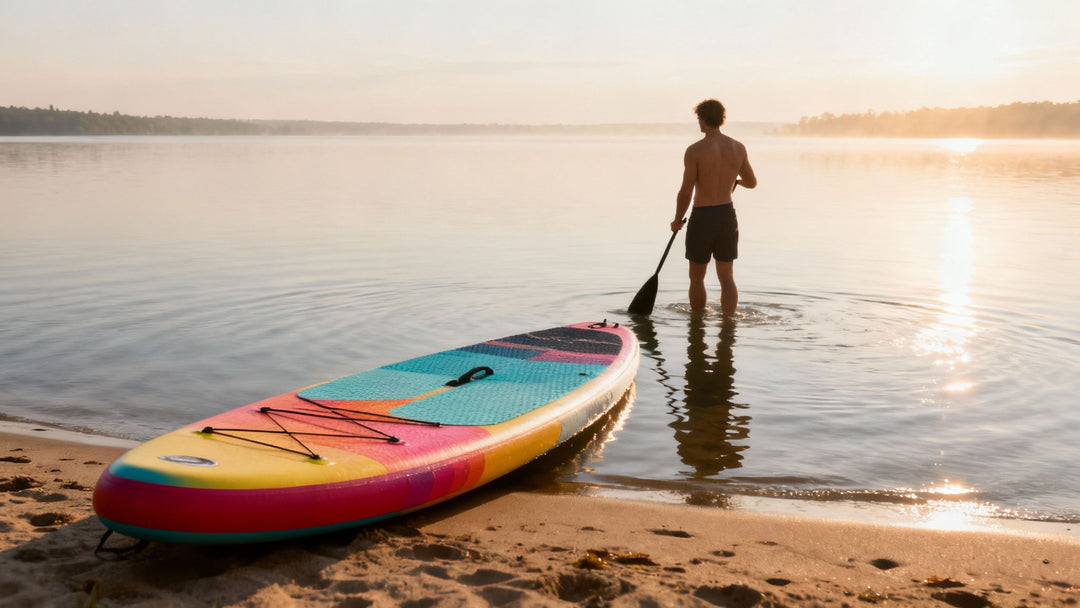What to Wear Paddle Boarding in the UK
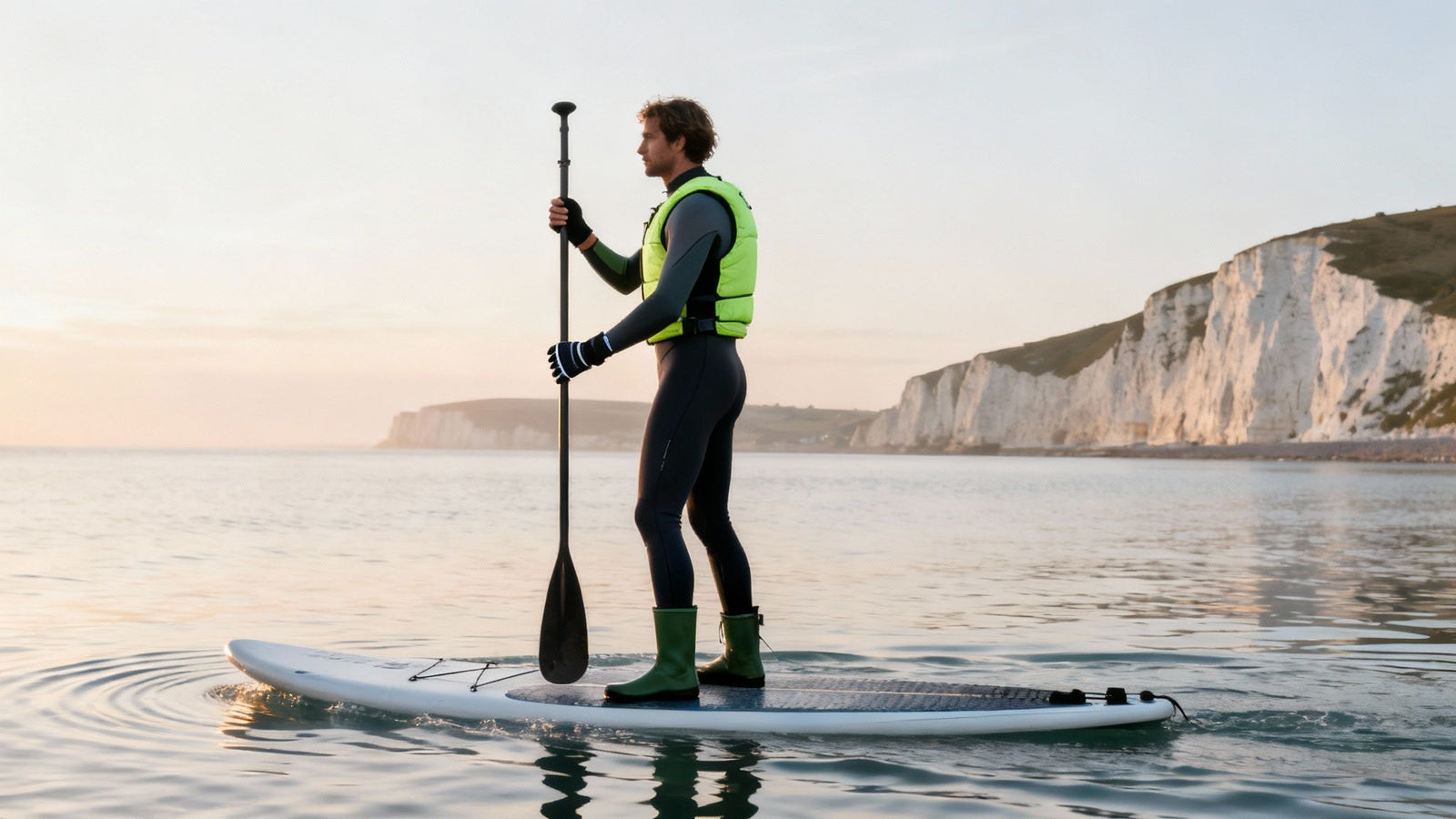
Figuring out what to wear when you go paddle boarding can seem a bit much at first, but it all comes down to one golden rule: dress for the water temperature, not the air temperature. For most paddling you’ll do in the UK, that means a wetsuit or some decent, quick-drying athletic layers are your best bet. Whatever you do, steer clear of cotton. It’s a total sponge for water and will make you dangerously cold if you take a tumble.
Your Essential Paddle Boarding Kit for UK Waters
Getting your clothing right is the very first step to having a good, safe time out on the water. Sure, a sunny day might make you want to throw on your usual beach gear, but the UK’s famously unpredictable weather and chilly waters call for a smarter approach. The best mindset is to always be ready for a swim, even if it's just an accidental slip.
With paddle boarding's popularity exploding, there’s a much bigger conversation happening around the right gear. As one of the fastest-growing watersports, more people are learning the hard way about dressing for the conditions. Here in the UK, our water can be as cold as 8°C in winter and might only creep up to around 17°C at the height of summer. This is exactly why you see so many paddlers in neoprene wetsuits. For a deeper dive into the growth of UK watersports, check out this piece on Yachting World. This makes layering the absolute cornerstone of your kit.
To give you a quick idea of how your gear changes through the year, here's a simple breakdown.
UK Paddle Boarding Attire at a Glance
This table is your cheat sheet for dressing appropriately, no matter the season.
| Season | Core Bodywear | Footwear | Essential Accessory |
|---|---|---|---|
| Spring | 3/2mm full wetsuit or long john with thermal rash vest. | 3mm neoprene boots. | Windproof jacket. |
| Summer | Thermal rash vest and board shorts/leggings. | Barefoot or water shoes. | Sun hat and polarised sunglasses. |
| Autumn | 4/3mm or 5/4mm full wetsuit. | 5mm neoprene boots. | Neoprene hood or warm beanie. |
| Winter | 5/4mm full wetsuit, potentially a drysuit. | 5mm+ neoprene boots and gloves. | Full thermal layers under wetsuit. |
Remember, this is just a guide. Always check the forecast and consider your own tolerance for the cold before you head out.
Core Clothing Items for Every Paddler
Your core kit needs to be adaptable enough to handle whatever a British day decides to throw at you. These pieces are the foundation you’ll build your paddle boarding wardrobe on.
- Wetsuit: A 3/2mm full-length wetsuit is a fantastic all-rounder for spring, summer, and autumn. It gives you that vital warmth in the water without feeling too bulky or restrictive when you're paddling. For example, wearing one for a paddle in Cornwall in May keeps you comfortable even if you fall in, but it's flexible enough for a long session.
- Rash Vest: An absolute non-negotiable. A good quality thermal rash vest, like the ones from Loco SUP, is brilliant. Wear it under a wetsuit for an extra layer of insulation or just with board shorts on a properly warm day. Its main job is to fend off the sun and stop any nasty chafing.
- Quick-Drying Shorts/Leggings: Look for gear made from materials like nylon or polyester. They shed water, dry out super fast in a breeze, and are comfortable enough to move in without a second thought.
- Windproof Jacket: A lightweight, packable windbreaker is worth its weight in gold. You can easily stash it in a dry bag and pull it on for instant protection the moment the wind picks up and the temperature plummets.
Key Takeaway: If you remember one thing, make it this: completely avoid cotton. Cotton clothes soak up water, get incredibly heavy, and suck the heat right out of your body. This seriously increases the risk of cold water shock and hypothermia.
Why Layering Is Your Best Friend
Think of your paddle boarding outfit like an onion – it’s all about the layers. This simple approach means you can adapt to changing conditions in seconds. You might start a chilly morning paddle feeling the bite, but quickly warm up once you get the blood pumping and the sun breaks through.
Being able to peel off a jacket or a thermal top makes all the difference. For instance, pairing a Loco thermal rash vest with a light jacket gives you perfect flexibility for one of those cool but sunny days.
Dressing for Summer Sunshine and Warm Paddles
Sunny days on the water are what we all dream of, but a classic UK summer still demands some smart clothing choices. It's tempting to strip down to just your swimmers, but the right gear will keep you comfortable, protected, and ready for those longer adventures on your board.
The golden rule here is to ditch the cotton and embrace modern, technical fabrics. Materials like quick-drying synthetics (think polyester or nylon) and anything with a UPF rating are your best friends for staying cool and shielded from the sun. These fabrics don't hold water, which means they won’t weigh you down or give you a chill if you get splashed or fancy a quick dip.
Your Go-To Summer Paddle Outfit
For a typical warm-weather session, you want to be thinking lightweight and functional. Let's say you're planning a long paddle along the coast; a lightweight, long-sleeved rash vest paired with board shorts is a perfect setup that stops you from getting frazzled by the sun without causing you to overheat.
This simple combination just works. The rash vest offers excellent UV protection for your torso and arms, while the board shorts give you all the comfort and freedom of movement you need. A great practical example is pairing a Loco SUP rash vest with a reliable pair of quick-dry shorts for a full day of exploring.
This visual guide breaks down the core gear choices for UK paddle boarding, really highlighting the most versatile options.

As the infographic shows, while a wetsuit is often a must-have, a quality rash vest is a key summer alternative. The one thing to always avoid? Cotton.
Sun Protection Is Non-Negotiable
Don't underestimate the sun when you're on the water. The reflection off the surface massively increases your UV exposure, making robust protection vital for your health and comfort.
A study by the World Health Organisation found that water can reflect up to 10% of UV radiation, which adds to the direct exposure you're getting from the sun. This makes comprehensive sun protection on the water even more critical than on land.
Your sun safety kit should always include these three things:
- Waterproof Sunscreen: Slap on a high-SPF, water-resistant sunscreen at least 20 minutes before you head out. Don't forget to reapply it regularly, especially if you've been in for a swim.
- A Secure Hat: A wide-brimmed hat or a cap is essential, but make sure it has a chin strap or retention cord. There's nothing worse than watching your favourite hat get whisked away by the wind.
- Polarised Sunglasses: These are a total game-changer. Polarised lenses cut the harsh glare from the water's surface, which reduces eye strain and lets you see what's going on beneath the surface much more clearly. Just like your hat, a retaining strap is a very wise investment.
For a deeper dive, you can learn more about how to protect your skin while paddle boarding in our dedicated article.
What About Your Feet?
Finally, let's talk footwear. The freedom of paddling barefoot is brilliant, but it isn't always the most practical choice, particularly when launching from the pebbly or rocky beaches we so often have here in the UK.
It really comes down to a simple pros-and-cons decision:
- Barefoot: This gives you the best board feel and connection. It’s perfect for sandy beaches where you have a smooth, clear entry into the water. For example, a calm day at a sandy spot like Bournemouth beach is ideal for paddling barefoot.
- Neoprene Shoes/Boots: These offer essential protection against sharp rocks, weaver fish, and other underwater hazards. They also add a bit of extra grip and warmth if the water is still on the chilly side. Loco Surfing's range of boots is designed specifically for these mixed conditions.
Layering for Autumn and Spring Paddling
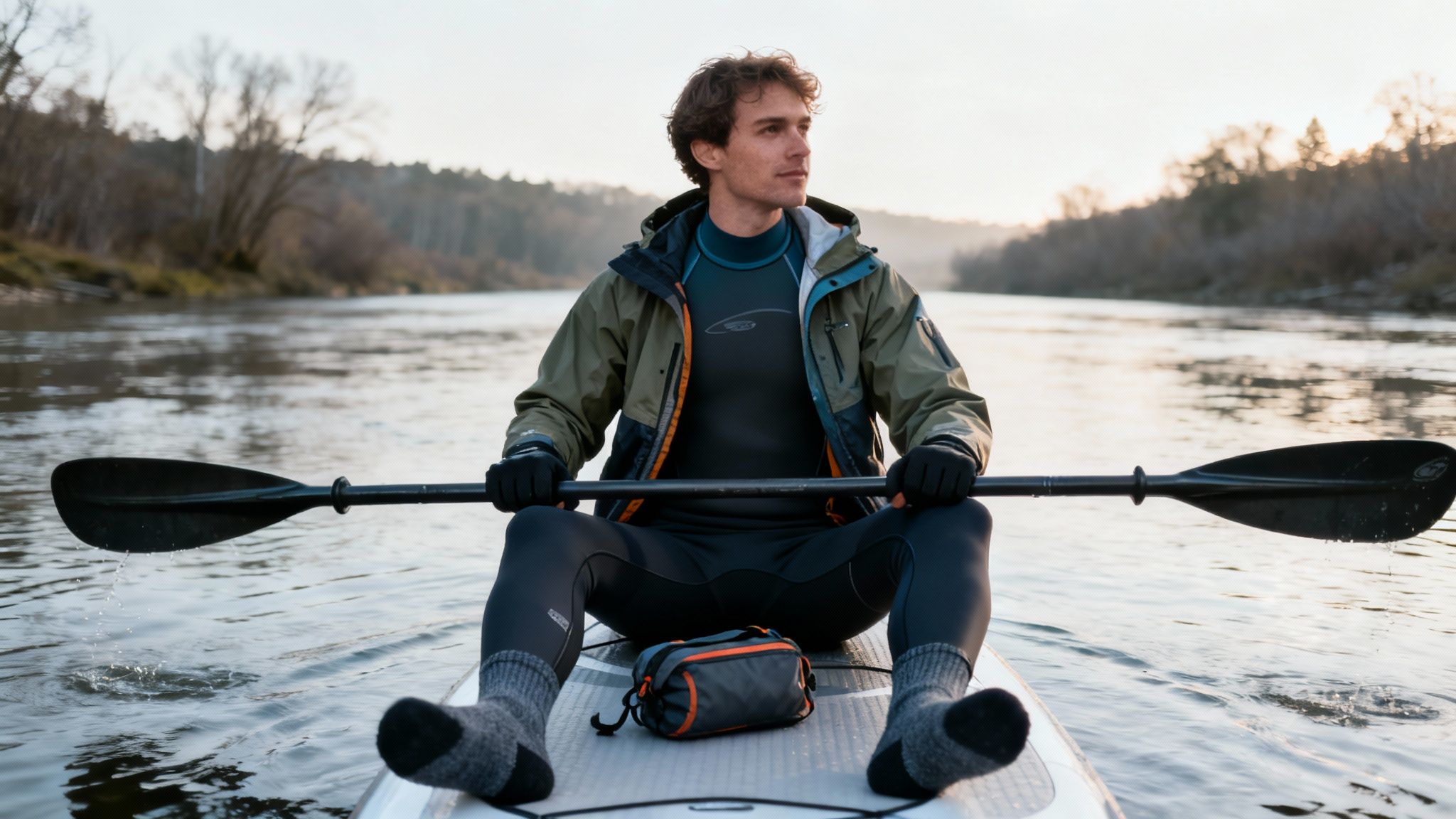
Autumn and spring often serve up the best paddling conditions you could ask for. Think glassy water, vibrant scenery, and a real sense of peace out there. But the catch is the temperature drop – both in the air and, more importantly, in the water. This is when a smart approach to what you wear becomes non-negotiable.
Getting your layering right is the secret to staying warm and comfortable, without overheating the moment you start putting in the effort.
The Three-Layer System Explained
This isn't some complex science; it's a tried-and-tested system that’s all about adaptability. Each layer has a specific job, and when they work together, they create a perfect little microclimate to keep you comfortable, no matter what the day throws at you.
- Base Layer: This is what’s right next to your skin. Its whole purpose is to pull sweat away from your body, keeping you dry. For UK waters, a good thermal rash guard, like the Loco thermal rash vest, is an absolute game-changer for this.
- Mid-Layer: This is your insulation layer, trapping body heat to keep you warm. A thin fleece or a neoprene top is ideal.
- Outer Shell: Your shield against the elements. This layer stops wind chill and spray from getting through. A lightweight, packable windproof or waterproof jacket is perfect.
For most of us paddling in these seasons, a full-length wetsuit is the real workhorse. It effectively combines the base and mid-layer into one core garment. A 3/2mm wetsuit is a brilliant all-rounder, giving you that sweet spot between warmth and the flexibility you need for a good paddle stroke. You can dive deeper into this in our guide to understanding wetsuit thickness and fit.
Picture this: You head out on a crisp October morning. To beat that early chill, you start with a windproof jacket over your wetsuit. An hour later, the sun's out and you're warmed up from paddling. You simply slip the jacket off, roll it up, and stick it under the bungee cords on your board. That's the beauty of layering in action.
Essential Accessories for Cooler Paddles
Your core might be toasty, but freezing hands and feet can cut a great session short. They’re usually the first to feel the bite, so getting them protected is crucial.
This is also where we need to talk seriously about safety. The latest figures show a consistent watersports fatality rate in the UK of around 0.87 fatalities per million participations between 2019-2023. It’s a stark reminder that wearing the right thermal gear is a safety issue, not just a comfort one. This is why groups like Paddle UK are now strongly recommending thermal wear like wetsuits to combat cold water shock and hypothermia.
With that in mind, these accessories aren't just nice-to-haves; they're essentials for spring and autumn paddling:
- Neoprene Gloves: They make a world of difference. Your hands stay warm and functional, which means you can keep a proper grip on your paddle for longer.
- Neoprene Boots or Socks: There's nothing worse than numb, wet feet. A solid pair of 3mm or 5mm neoprene boots will keep your toes happy, even when you have to step into chilly water to launch your board. Brands like Loco Surfing have a great range of tough accessories built for exactly these kinds of UK conditions.
Conquering the Cold with Winter SUP Gear
Paddling on a crisp, still winter's day is a special kind of magic, but it demands absolute respect for the conditions. If you want to extend your season year-round, specialist gear isn’t just about comfort—it's essential for your safety. Getting your winter kit right means you can confidently enjoy the unique peace of cold-water paddling without putting yourself at risk.
The core of any winter setup comes down to one big choice: a thick wetsuit or a drysuit. They protect you in fundamentally different ways. A winter wetsuit, typically 5mm thick or more, works by trapping a thin layer of water between the suit and your skin. Your body then heats up this water, creating an insulating barrier against the cold. They’re snug, flexible, and perfect for paddlers who might still be taking the occasional dip.
A drysuit, on the other hand, is a completely waterproof outer shell with tight seals at the neck and wrists designed to keep every single drop of water out. This means you stay completely dry underneath. All your warmth comes from the thermal layers you choose to wear beneath it.
Wetsuit vs Drysuit for Winter Paddling
So, which one is for you? The decision often comes down to your budget and the kind of paddling you plan on doing. Drysuits offer unbeatable protection from wind and water, but they do come with a much higher price tag. Once you get used to the slightly baggier fit, they can feel less restrictive than a thick wetsuit, allowing for excellent freedom of movement.
Wetsuits are the more affordable and widely available option. A good quality 5/4mm wetsuit, like those available from Loco Surfing, provides brilliant thermal protection for most UK winter conditions. While they are naturally more restrictive than a drysuit, modern neoprene technology has made them incredibly flexible and comfortable enough for a good long paddle.
It's crucial to remember that any water below 15°C can induce cold water shock. This is a very real danger, no matter how experienced you are. To get clued up on staying safe, the RNLI offers excellent guidance on cold water shock.
Non-Negotiable Winter Accessories
Once you've sorted your core warmth with a suit, your extremities are the next priority. Losing heat from your head, hands, and feet will end your session faster than anything else. These accessories are absolute must-haves for winter paddling.
- Thick Neoprene Boots: Your feet are usually the first thing to feel the chill, especially when launching from a cold beach or slipway. Look for boots that are at least 5mm thick to keep your toes functional and warm.
- Neoprene Gloves or Mittens: Cold, stiff hands make it impossible to grip your paddle properly, which is not only uncomfortable but unsafe. Gloves offer more dexterity, but mittens are generally warmer. High-quality accessories, like those from Loco Surfing, are designed specifically for the demands of UK waters.
- Warm Headwear: You lose a huge amount of body heat through your head. A woolly beanie might be fine for calm, dry days, but a neoprene hood is the best choice for providing serious insulation, especially when it’s windy or wet.
Don't Even Think About Paddling Without This Safety Gear
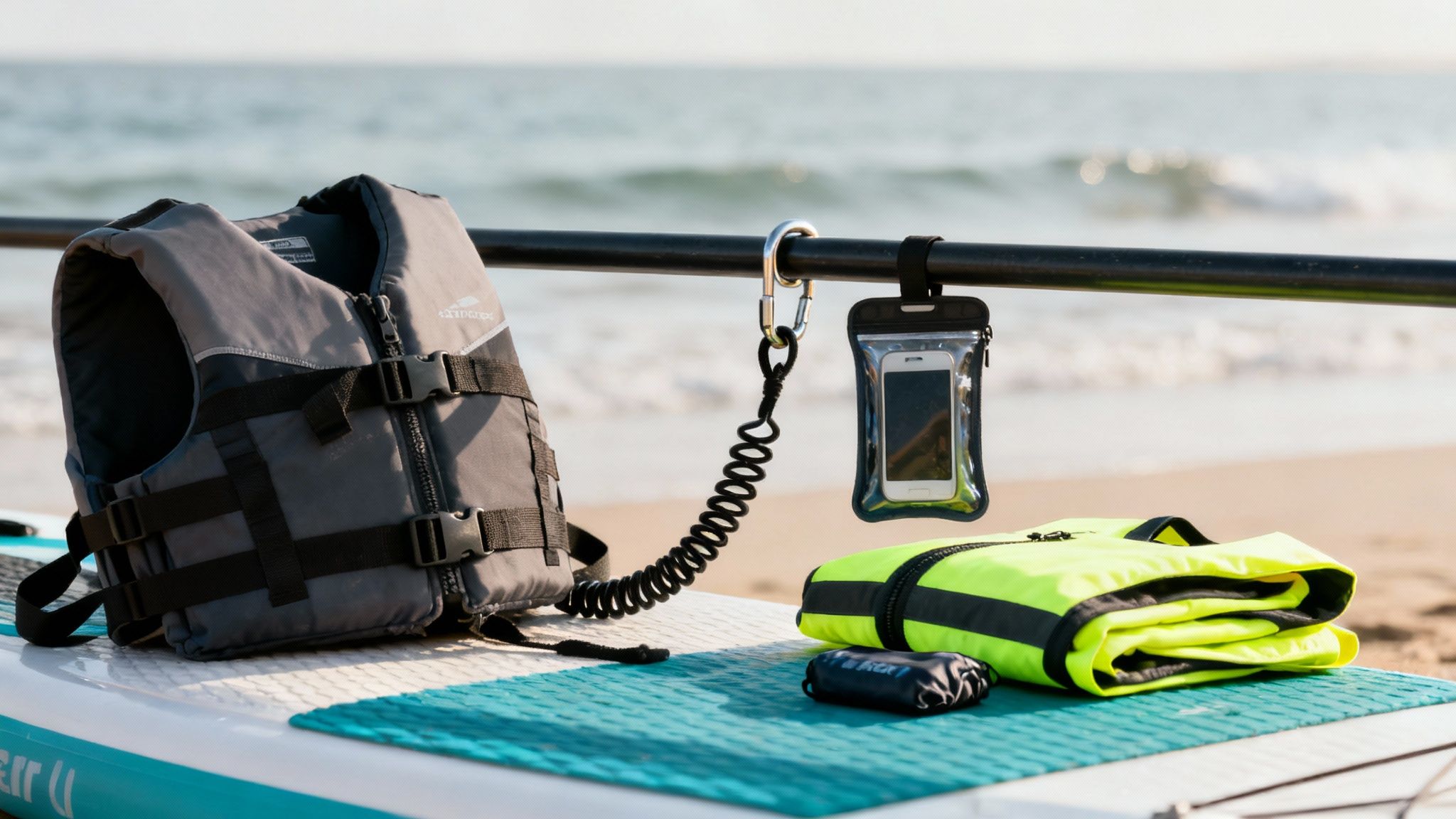
While the right clothing is your first defence against the elements, a few pieces of safety gear are simply non-negotiable every time you hit the water. Thinking about what to wear paddle boarding is about more than just clothes; it’s about a complete system that keeps you safe out there.
These items aren't just good ideas—they are lifesavers.
First up, your personal flotation device (PFD) or buoyancy aid. This is, without a doubt, the single most important bit of kit you can own. Modern PFDs are comfortable and designed for a full range of movement, so there's really no excuse for leaving yours on the shore.
A well-chosen PFD is absolutely critical. While there are countless styles out there, a good guide to the best inflatable life jackets for NZ waters can help you figure out what features to look for, no matter where you paddle. Getting the fit right is just as important. For a deeper dive, have a look at our complete guide on choosing a paddle boarding life jacket to make sure you get the perfect one for your needs.
Your Lifeline: The Leash
Next on the list is your leash. Never, ever paddle without one. Seriously.
Your board is your number one float, and if you fall in—especially in windy or choppy water—it can get swept away from you in seconds. A leash is the simple bit of kit that keeps that giant float securely attached to you.
For most of us, a coiled leash is the way to go. It stays on the board and out of the water, which means less drag. A tough, reliable leash is a must, designed to handle the rough and tumble of UK conditions and ensure that vital connection is always there when you need it. A practical example is using a coiled leash for flat water paddling on a lake, but switching to a straight leash for SUP surfing to reduce tangles.
Key Takeaway: Your leash and PFD are a team. The PFD keeps you afloat, and the leash keeps your board within arm's reach. Always use both, every single time.
Stay Seen and Connected
Being visible to boats, jet skis, and other water users is a huge safety factor, particularly on busy waterways. This is exactly why bright, high-vis clothing can make such a difference.
Data from Paddle UK's Annual Safety Report backs this up, showing that collisions with boats are a real concern. It's prompted a lot of paddlers to switch to high-visibility gear just to stand out. That same report points out how often paddlers get caught out by bad weather, making visibility even more crucial.
Finally, always carry a way to call for help. A fully charged mobile in a waterproof pouch is your lifeline to shore. You can use it to check the weather, call for help in an emergency, or just let someone know you're running a bit late. Along with your phone, a small dry bag is brilliant for stashing an extra layer, some snacks, and your keys, keeping everything safe while you're out enjoying the paddle. For example, a 5L dry bag is perfect for holding a Loco windproof jacket, car keys, and a phone.
Year-Round Paddle Boarding Safety Checklist
No matter the season, a quick check of your safety gear before you launch is one of the smartest habits you can build. This isn't about being paranoid; it's about being prepared so you can relax and have a great time on the water.
Here’s a simple checklist of the essentials every paddler should have.
| Item | Purpose | When to Use |
|---|---|---|
| PFD / Buoyancy Aid | Provides flotation to keep you safe if you fall in. | Every single trip, no exceptions. |
| Leash | Keeps your board connected to you. Your board is your biggest float! | Every single trip, especially in wind or chop. |
| Communication Device | To call for help or check weather updates. | Every single trip. Keep it in a waterproof pouch. |
| High-Visibility Clothing | Makes you easily seen by other water users, like boats. | Always, but especially in busy areas, fog, or low light. |
| Dry Bag | Keeps spare clothes, phone, keys, and snacks dry and safe. | Any trip where you need to carry extra items. |
| Whistle / Horn | An audible signal to attract attention in an emergency. | Always. Many PFDs have one built-in. |
| Appropriate Footwear | Protects feet from sharp objects and provides grip. | Most conditions, unless you're on a sandy beach. |
Running through this list before you go gives you peace of mind. It means you’ve thought through the 'what ifs' and can focus on the paddle itself, knowing you're well-equipped for a safe day out.
Common Questions About Paddle Boarding Clothing
As you get into paddle boarding, you'll find a few key questions about kit tend to pop up again and again. Getting the answers right makes a huge difference to how comfortable and safe you feel out on the water. Let’s run through some of the most frequent queries we hear.
Can I Just Wear My Gym Clothes?
It’s a tempting thought, especially when the sun’s out. And you know what? For a casual summer paddle, your technical gym gear—the polyester or nylon stuff—is actually a pretty decent shout. It's lightweight, doesn’t turn into a lead weight when wet, and dries off in a flash.
But there’s one golden rule here: absolutely avoid cotton. That comfy old T-shirt you love? It’ll act like a sponge, soaking up every drop, getting heavy, and chilling you to the bone the second you take a dip. So, for summer, technical gym kit gets a thumbs up, but cotton is always a hard no.
Do I Really Need a Wetsuit for a UK Summer?
This is the classic "it depends" situation, isn't it? A UK summer can swing from a glorious 25°C to a brisk 15°C with a nippy breeze, sometimes in the same afternoon. The right choice really comes down to a few practical things.
- Water Temperature: Even in August, UK sea temperatures rarely climb above 17-18°C. That’s still cold enough to give you a proper shock if you're not prepared.
- Your Stability: Let's be honest, how likely are you to fall in? If you're just starting out or trying a tippier board for the first time, the chances are a lot higher.
- How You Feel the Cold: Some of us run hot, others get chilly just looking at the water. If you know you're prone to feeling the cold, a wetsuit is just common sense.
For a quick paddle in the sunshine, close to the shore, you might be perfectly happy in shorts and a Loco SUP thermal rash vest. But for a longer coastal tour or if there’s any doubt at all, a 3/2mm wetsuit is the smarter, safer bet every time.
What's the Difference Between a Wetsuit and a Drysuit?
This is a really important one, especially if you start thinking about extending your paddle season into the colder months. They both keep you warm, but they go about it in completely different ways.
A wetsuit is designed to work when it's wet. It traps a thin layer of water between the neoprene and your skin, which your body quickly heats up. This warm layer then acts as insulation against the cold water outside.
A drysuit, on the other hand, is a completely sealed, waterproof shell. It doesn't let a drop of water in, so you stay totally dry underneath. The warmth comes from whatever thermal layers you choose to wear beneath it. Drysuits offer incredible protection from the elements, but they are a much bigger financial investment.
What Shoes Are Best for Paddle Boarding?
Footwear often boils down to personal preference and where you're launching from. Each option has its own clear pros and cons.
- Barefoot: This gives you the best feel and connection to your board. It’s perfect for launching from a sandy beach where you don’t need to worry about anything sharp underfoot.
- Neoprene Boots: These are the number one choice for warmth and protection. They're pretty much essential for paddling in cooler water and for shielding your feet from rocks or the dreaded weaver fish.
- Water Shoes: Think of these as a great middle ground. They offer solid sole protection and decent grip, all while being lightweight and quick to dry.
As you build out your kit, you'll probably find yourself buying gear online. Knowing how to get the right fit and features without trying things on can save a lot of hassle. For some solid advice on this, it's worth learning how to confidently shop for clothing online.
Ready to find the perfect gear for your next adventure on the water? The expert team at Loco Surfing is here to help you choose the right clothing and accessories for any condition. Explore our full range of high-performance apparel and equipment today at https://www.locosurfing.com.


